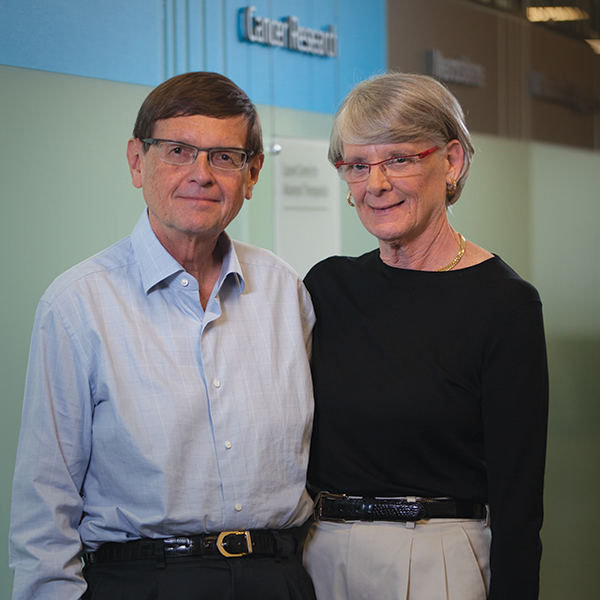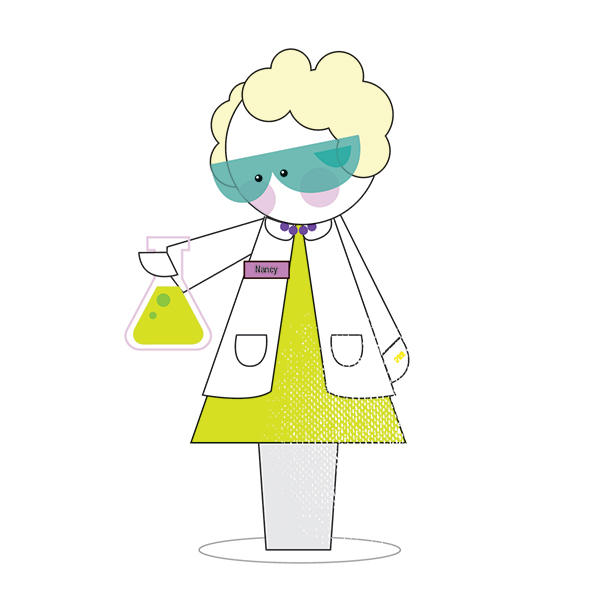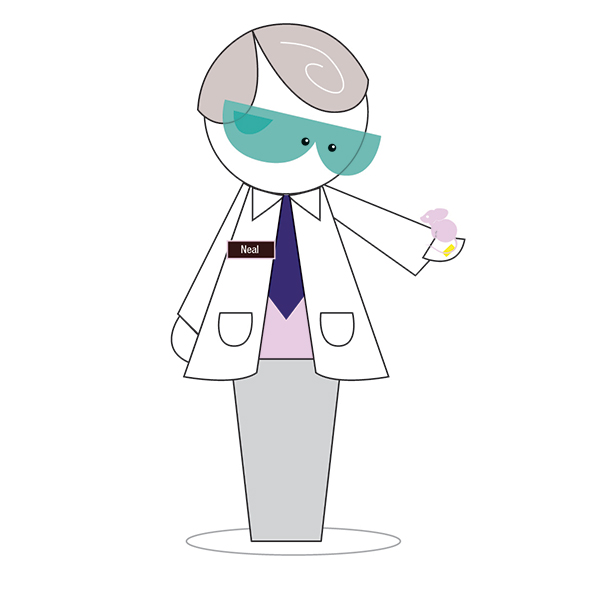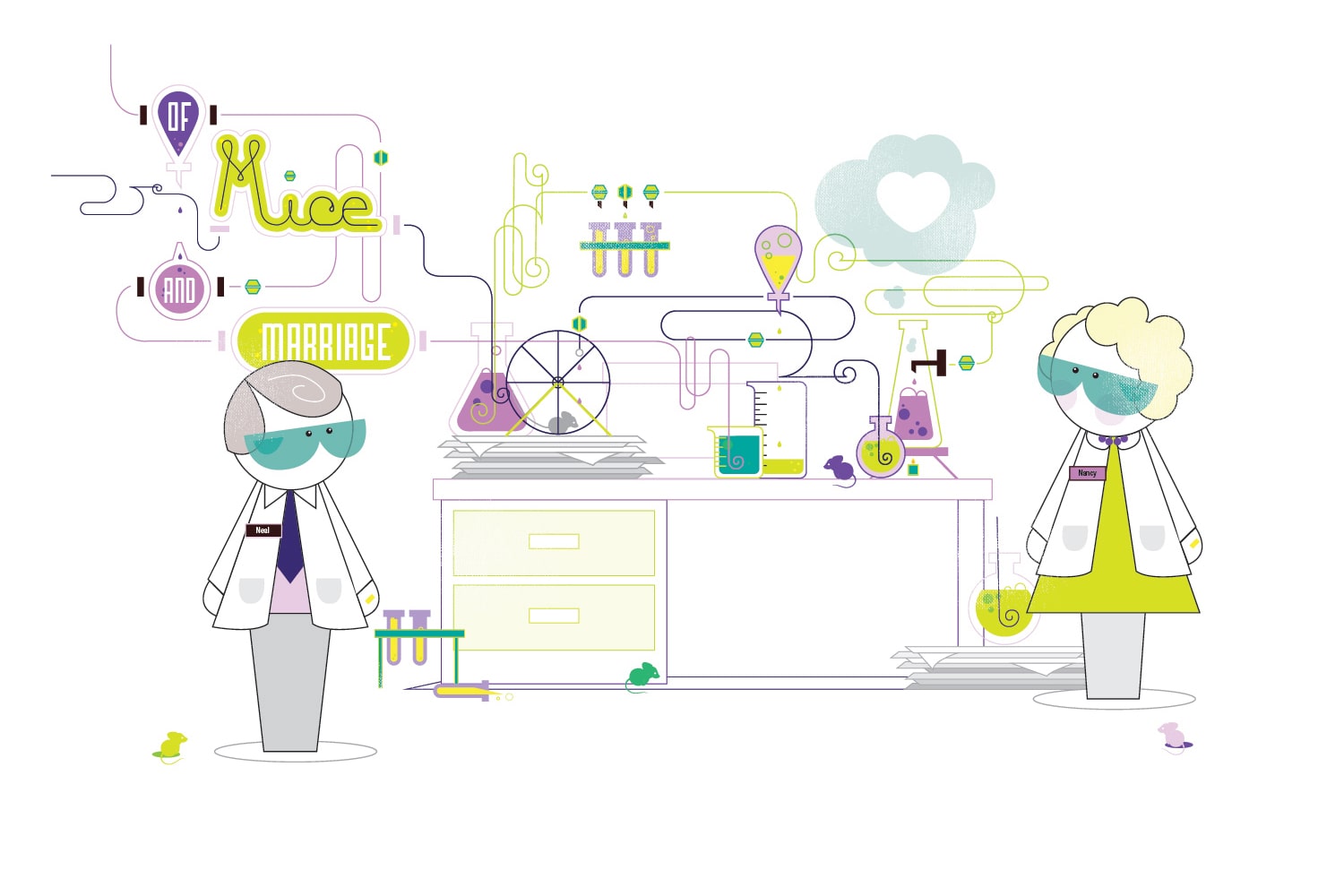CANCER RESEARCH, from the laboratory to the doctor’s office, hinges on fruitful collaboration—and the ability to turn promising data into meaningful treatment.
But to refer to the partnership between cancer geneticists Nancy Jenkins and Neal Copeland as “fruitful” would be like calling the Grand Canyon a “hole” or the Empire State Building an “office space.” If the field of cancer genetics has a power couple—think Angelina Jolie and Brad Pitt, with lab coats and less hair—it’s Jenkins and Copeland.
Since September 2011, from a shared office in the heart of the Methodist Hospital Research Institute in Houston, within one of the largest medical complexes in the world, Jenkins and Copeland have led the institute’s Cancer Research Program. It is dedicated to translational research—turning scientific findings into beneficial treatments as quickly as possible. Before moving to Houston, the couple, now in their 60s, spent three decades building their reputations on identifying disease-causing genes and modeling those diseases in mice in order to learn more about how they might work in humans. Now, in their most ambitious collaboration to date, they are starting their fourth decade together by using the mouse data to try to find targets for new cancer treatments.

LOVE IN THE LAB: Over the last 35 years, the partnership of Neal Copeland and Nancy Jenkins has advanced the understanding of cancer genetics. Photo courtesy of Neal Copeland and Nancy Jenkins
A Genetic Link
Copeland and Jenkins met in 1977 when they began working together as postdoctoral researchers in a molecular virology laboratory at the Dana-Farber Cancer Institute in Boston. Jenkins was fresh from completing her PhD at Indiana University; Copeland had joined the lab a year earlier, after finishing his doctorate at the University of Utah. Love bloomed: They married in 1980 when Copeland was 33 and Jenkins was 30.
Science also bloomed: Over the next three decades, the couple would co-author nearly 800 scientific papers, hundreds of which connected genetic pathways to the formation or growth of cancer. They became legendary for developing enormous colonies of mice—some with spontaneous mutations, others that were genetically engineered—that allow researchers to study diseases like cancer, and in some cases to test treatments before introducing them to human subjects. And the couple paid it forward, training an entire generation of scientists in cancer research.
Copeland and Jenkins also created new methods for identifying genetic mutations in cancer cells, and as true pioneers in the digital age of cancer research, they are collecting vast stores of genetic data on cancer, with the intent to release much of it publicly online. All of these efforts have made them two of the most highly cited biomedical scientists in the world. This lifelong work also resulted in their induction, in 2009, into the prestigious National Academy of Sciences. And they’re still going strong: In a study published in April 2012 in Proceedings of the National Academy of Sciences, the couple and their colleagues turned up 500 genetic mutations that play a role in the formation of the most common kind of pancreatic cancer. The study is already being used to identify new drug targets.
Take a quick look at Neal Copeland and Nancy Jenkins’ work.
They don’t treat cancer patients directly, but Neal Copeland and Nancy Jenkins have been influencing new cancer treatments—behind the scenes—since they married in 1980. Here’s a quick look.
They have:
- Used mice to identify the protein EVI1 and tie it to the growth of myeloid leukemia and many epithelial cancers. (EVI1 has since been linked to additional cancers.)
- Identified new genes linked to leukemia in mice and humans.
- Worked with other researchers to develop better mouse models of cancer.
- Helped show why patients treated for X-linked SCID, an immunodeficiency disorder, may go on to develop leukemia.
- Showed how researchers can shuttle a segment of synthetic DNA called Sleeping Beauty around on a gene, using it as a tool for identifying genes that cause cancer.
- Been part of a team of scientists that identified 500 genetic mutations that are associated with pancreatic cancer.
A Mouse Mecca at the National Cancer Institute
Over the years, Copeland and Jenkins have garnered tremendous prestige and funding. But they remain down to earth. In fact, they share an office in Houston, just as they did 33 years ago when they moved to Bar Harbor, Maine, to become the first molecular biologists to work at the Jackson Laboratory, a major genetics research institution that uses the mouse as a tool. Back then, their friends said they were crazy, and that the move would torpedo their careers. They also pointed out that the couple, at that point, knew little about mice. “We thought maybe we could combine molecular biology with mouse genetics,” says Copeland. “We would teach [geneticists] molecular biology, and they would teach us mouse genetics.”
There was a steep learning curve, but as Copeland and Jenkins found their way, they decided to use retroviruses to alter the genes of mice they were studying. A retrovirus invades and inserts its own DNA into the existing genome of a host cell. As a result, the co-opted host cell blindly follows the directions encoded in the virus DNA. In the 1970s, scientists inserted genetic messages into the DNA of fruit flies that were equivalent to the ones a retrovirus would send, to identify which changes led to disease. Copeland and Jenkins were inspired by this work to use actual retroviruses to insert genetic changes into mouse DNA. By mutating those genes, they could identify the genetic switches that caused cancer.
While the couple was learning how to find cancer-causing genetic mutations in mice, they also had to make big choices about how they wanted their personal and professional lives to unfold.
“When we got married,” says Copeland, “we decided we weren’t going to have any children” because it would have made Jenkins’ scientific career more difficult. “We [also] knew we would be working together and running a lab together, or running two separate labs”—and competing—“so we decided to work together and run the lab together.”
“We had one small office,” he adds. “After we became more well known and moved around, we could have had separate offices, but we decided we liked working that way.”
And move around they did. After three productive years at the Jackson Laboratory, they began to get restless.
“Nancy decided she couldn’t live in Maine,” Copeland recalls, speaking from their Houston office, sitting next to his wife.
“You didn’t like it, either!” counters Jenkins.

“Nancy’s very organized,” says her husband, Neal Copeland. “She’s got lists for lists and lists of lists. I’m more the dreamer.”
Copeland laughs. “In the ’80s, there was no such thing as cable TV or internet or email,” he says. “We were isolated and cold, with nothing to do. But that was good! We worked every day.”
They ended up at the National Cancer Institute (NCI), which offered both of them jobs at its campus in Frederick, Md. “The reason we went to the NCI in the first place was that they gave us enormous resources,” says Jenkins. “They supported almost 10,000 cages of mice for us, and that’s huge. I think that’s probably one of the largest personal research colonies in the United States.”
With that kind of support, Copeland and Jenkins had the freedom and resources to launch large-scale research projects. They waded into genomics—research investigating the sum total of all the genes in an organism—before the field really became popular. They set out to determine how mouse genes were related to one another, and then to build a map showing those relationships. “Having these thousands and thousands of cages of mice allowed us to do all kinds of things,” says Copeland.
Their method involved breeding wild mice—mice captured outside a lab—with mice inbred in their lab. They then took the resulting mice, crossbred them again with their lab’s inbred mice, and studied the DNA of hundreds of offspring. Mouse by mouse and gene by gene—and with hundreds of collaborators, including a generation of postdoctoral students—they figured out which chromosomes host which mouse genes as well as the genes’ positions on the chromosomes. They connected specific genetic mutations to specific characteristics, like a mouse’s coat color. They also connected mutations to the emergence of disease and searched the human genome for similar genes that might also play important roles in a number of illnesses, including cancer’s development and spread.
Copeland and Jenkins’s work is routinely credited by their colleagues and other experts with having played a pivotal role in advancing the use of mice to study cancer genetics. But they remain modest, chalking up their success to having had access to the financial resources required for large-scale projects, the freedom to pursue research they found promising, and the talented young researchers they trained. “It turned out to be a magical life—I can’t believe we have the life we’ve had,” says Copeland. “We could basically do whatever we wanted, but we just had to be productive.”
Copeland says they work together so well because they complement each other’s strengths. “Nancy’s very organized. She’s got lists for lists and lists of lists,” he says. “I’m more the dreamer.”
To Singapore and Beyond
Based on their research output, it might seem that Jenkins and Copeland spend all of their time in the lab. But work isn’t their entire life. They are both accomplished cooks—though Copeland does most of the cooking. “We’re food junkies to the extreme,” he says. “I like to cook. A lot of men who are scientists like to cook, and I think there’s some connection with working in the lab.”
The couple also developed a taste for wine—Copeland had a 2,000-bottle wine cellar built in the house they had in Maryland—and travel. They’ve been to every continent but Antarctica, exploring and eating their way through places such as Europe, South Africa, the Indian subcontinent and Southeast Asia—one of their favorite destinations.
So when they were recruited to move to Singapore to join its Institute of Molecular and Cell Biology in 2006, the offer was a perfect match. Not only would they live in Asia, but Singapore was offering them huge financial grants to conduct their research, with no strings attached. They didn’t see how they could say no.
Shortly before moving, the couple published a study in Nature that introduced a new way to induce human cancers in mice, and while in Singapore they used this method to model more than 15 different human cancers in the animals. “We couldn’t have done that experiment anywhere in the U.S.,” says Jenkins. “It was too expensive and requires huge amounts of space and resources.”

Neal Copeland and Nancy Jenkins are collecting vast stores of genetic data on cancer, with the intent to release much of it publicly online.
Then, says Jenkins, the Singapore government changed its funding model. Instead of offering funding for pure science projects like those Jenkins and Copeland were conducting, the government required that projects have immediate applications in industry as well as obtain one-third of their financial support from commercial sources, such as pharmaceutical companies. Genomics research rarely translates quickly into tangible benefits, and the couple believed their work no longer fit within the philosophy of the center. They decided to leave. In 2011, they moved again, this time to Houston to head up the Cancer Research Program at Methodist Hospital. Their transition was made possible by the Cancer Prevention and Research Institute of Texas, a $3 billion voter-approved endeavor that aims to make the state a major player in cancer research. The institute awards lucrative grants to innovative researchers working in Texas, and Jenkins and Copeland were among the first scholars to be recruited, receiving an initial $7.5 million apiece to establish their research.
According to Stephen Wong, a bioengineer who leads Methodist Hospital’s branch of the NCI’s Integrative Cancer Biology program, the new institute “put Texas on the map in terms of cancer research”—and recruiting Jenkins and Copeland showed that the program was serious. “They are very open, and great scientists, and it’s good to have them around,” he says. “They are leaders and visionaries, and they’re a delight to work with.”
Copeland and Jenkins’ current project may be their biggest venture yet. They’re gathering all the data they’ve collected on mice genes—from all the different mouse varieties they’ve developed, over all their decades of work—and building a database that any cancer scientist can consult, anywhere, at any time, to do research that might range from identifying possible gene targets for new therapies to determining subsets of patients most likely to benefit from a drug.
Meanwhile, Copeland and Jenkins will be using the data themselves to pursue their own Texas-sized goal: “We want to use this information to identify drug targets and maybe even develop some drugs,” Jenkins says.
According to both husband and wife, there’s still a lot more research to come from their partnership. After all, they make a good team.
“We’re pretty compatible,” says Copeland, “the two of us.”
Cancer Today magazine is free to cancer patients, survivors and caregivers who live in the U.S. Subscribe here to receive four issues per year.





